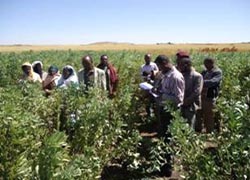In Ethiopia, N2Africa project activities are implemented in 27 Woredas (Districts) over four regions (Amhara, Benishangul-Gumuz, Oromia and Southern region) in partnership with national, international and private institutions and NGOs, thus promoting N2-fixation and legume production technologies among smallholder farmers. The project targeted four legume crops in Ethiopia (soybean, common bean, Faba bean and chickpea). Activities on faba bean (FB) focused at Bale zone in Oromia and Amhara (Adet and Debark/Dabat Woredas) in collaboration with the regional research institutes, the ARARI (Amhara Regional Agri. Research Institute) and OARI (Oromia Agri. Research Institute). When N2Africa touched base in Ethiopia in 2012, Sinana Agricultural Research Center (SARC) of the OARI was involved on FB variety adaptation trials and multiplication of the seeds of improved varieties (on station) to make seeds available in sufficient quantity for N2Africa activities during the bridging year in 2013. Promotion of N2Africa technologies on Faba bean at Bale zone targeted a number of Woredas including Sinana, Goba and Agarfa. These Woredas represent a cool-wet highland agroecology in Bale zone and known to have a bimodal rainfall pattern, locally known as ‘Bona/Meher’ which extends from August to December and the second one, locally called ‘Ganna/Belg’, from March to July.
During the bridging year, in 2013, N2Africa conducted, in collaboration with SARC, input and variety trials and established demonstration plots on farmer’s fields. Preliminary results have shown that inoculation and/or phosphorus fertilizer increase grain yield of faba bean by up to 17% as compared to control plots (without inputs). During the 2014 growing season "best bet" technologies (improved seeds, effective strains, application of phosphorus fertilizer and improved agronomic practices) were promoted for adaptation by hundreds of farmers. Improved FB performances in the demonstration and adaptation activity clusters in 2013/14 have resulted in increased demand for N2Africa technologies (inoculants and improved seeds) among farmers in the target Woredas. In the 2014 growing season, altogether 415 farmers were reached with N2Africa technologies in the diagnostic, demonstration and adaptation cluster activities.
 |
 |
Figure 1. Male and female farmers visiting faba bean demonstration plots on farmer’s field day (note the plant height and vigor of the FB stands) |
|
The Bale highland is traditionally dominated by a cereal mono-cropping system, where barley/wheat is continuously grown. Because of this practice, the area suffers from outbreak of new diseases, depletion of soil fertility and infestation by grass weeds which reduces yield. OARI recognized pulses such as faba bean as a potential crop which can be grown in rotation to break the mono-culture cropping practice in the zone. In line with this, the introduction of N2Africa technologies (improved seeds, inoculant and P fertilizer application) brought about new opportunities to farmers and the demand for improved seeds and efficient FB inoculant has now increased to grow FB in rotation. In addition, the PPP (private public partnership) that N2Africa is now promoting created input and output value chain around legume production activities, thus creating new market opportunities in these districts. In recognition of N2Africa’s role and partnership to promote legume production and productivity of agriculture in the Bale zone, the OARI-SARC in Oromia Region granted a certificate to N2Africa-Ethiopia project in November 2014 (Figure 2). |
Figure 2. Certificate issued to N2Africa in recognition of its roles and contribution in promoting N2fixation and legume production technology in the Bale Zone of Oromia region, Ethiopia (the certificate reads in Oromiffa and Amharic languages). |
Compiled by N2Africa-Ethiopia national team (Endalkachew, Birhan and Tamiru)

